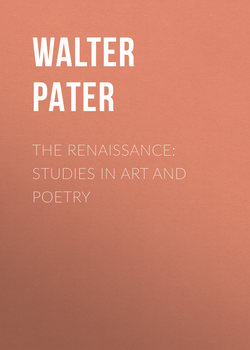Читать книгу The Renaissance: Studies in Art and Poetry - Walter Pater - Страница 4
SANDRO BOTTICELLI
ОглавлениеIn Leonardo's treatise on painting only one contemporary is mentioned by Name—Sandro Botticelli. This pre-eminence may be due to chance only, but to some will rather appear a result of deliberate judgment; for people have begun to find out the charm of Botticelli's work, and his name, little known in the last century, is quietly becoming important. In the middle of the fifteenth century he had already anticipated much of that meditative subtlety, which is sometimes supposed peculiar to the great imaginative workmen of its close. Leaving the simple religion which had occupied the followers of Giotto for a century, and the simple naturalism which had grown out of it, a thing of birds and flowers only, he sought inspiration in what to him were works of the modern world, the writings of Dante and Boccaccio, and in new readings of his own of classical stories: or, if he painted religious incidents, painted them with an under-current of original sentiment, which touches you as the real matter of the picture through the veil of its ostensible subject. What is the peculiar sensation, what is the peculiar quality of pleasure, which his work has the property of exciting in us, and which we cannot get elsewhere? For this, especially when he has to speak of a comparatively unknown artist, is always the chief question which a critic has to answer.
In an age when the lives of artists were full of adventure, his life is almost colourless. Criticism indeed has cleared away much of the gossip which Vasari accumulated, has touched the legend of Lippo and Lucrezia, and rehabilitated the character of Andrea del Castagno; but in Botticelli's case there is no legend to dissipate. He did not even go by his true name: Sandro is a nickname, and his true name is Filipepi, Botticelli being only the name of the goldsmith who first taught him art. Only two things happened to him, two things which he shared with other artists:—he was invited to Rome to paint in the Sistine Chapel, and he fell in later life under the influence of Savonarola, passing apparently almost out of men's sight in a sort of religious melancholy, which lasted till his death in 1515, according to the received date. Vasari says that he plunged into the study of Dante, and even wrote a comment on the Divine Comedy. But it seems strange that he should have lived on inactive so long; and one almost wishes that some document might come to light, which, fixing the date of his death earlier, might relieve one, in thinking of him, of his dejected old age.
He is before all things a poetical painter, blending the charm of story and sentiment, the medium of the art of poetry, with the charm of line and colour, the medium of abstract painting. So he becomes the illustrator of Dante. In a few rare examples of the edition of 1481, the blank spaces, left at the beginning of every canto for the hand of the illuminator, have been filled, as far as the nineteenth canto of the Inferno, with impressions of engraved plates, seemingly by way of experiment, for in the copy in the Bodleian Library, one of the three impressions it contains has been printed upside down, and much awry, in the midst of the luxurious printed page. Giotto, and the followers of Giotto, with their almost childish religious aim, had not learned to put that weight of meaning into outward things, light, colour, everyday gesture, which the poetry of the Divine Comedy involves, and before the fifteenth century Dante could hardly have found an illustrator. Botticelli's illustrations are crowded with incident, blending, with a naive carelessness of pictorial propriety, three phases of the same scene into one plate. The grotesques, so often a stumbling-block to painters who forget that the words of a poet, which only feebly present an image to the mind, must be lowered in key when translated into form, make one regret that he has not rather chosen for illustration the more subdued imagery of the Purgatorio. Yet in the scene of those who "go down quick into hell," there is an invention about the fire taking hold on the upturned soles of the feet, which proves that the design is no mere translation of Dante's words, but a true painter's vision; while the scene of the Centaurs wins one at once, for, forgetful of the actual circumstances of their appearance, Botticelli has gone off with delight on the thought of the Centaurs themselves, bright, small creatures of the woodland, with arch baby face and mignon forms, drawing tiny bows.
